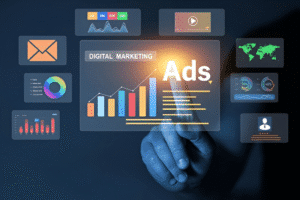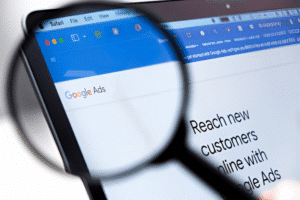Are you frustrated by your Google Ads spending a lot without delivering satisfactory outcomes? Understand how Google Ads Quality Score works, what factors influence it, and practical steps to improve ad relevance, landing page quality, and cost-efficiency.
Google Ads Quality Score – Key Takeaways
What if I told you there’s a single metric that could dramatically reduce what you’re paying per click while simultaneously improving where your ads appear? It’s not a myth, it’s your Quality Score, and mastering it might be the game-changer your campaigns desperately need.
Improving this single metric can slash your cost-per-click (CPC) while boosting your ad positions. Google’s rating for the quality of your ads is a powerful tool that many digital marketers fail to take full advantage of. This rating assesses how relevant and useful your ads are to users. By improving your Quality Score, you can reduce costs & increase the effectiveness of your online advertising campaigns.
This powerful 1-10 rating affects both how much you pay and where your ads show up. The best part? To emphasize, even small enhancements may result in significant cost reductions and enhanced visibility. Let me show you exactly how to harness this hidden force in your Google Ads campaigns.
Google Ads Optimization Strategy Guide
What Makes Quality Score So Crucial?
Before diving into tactics, you need to understand why Quality Score matters so much. Google rewards relevance and quality, not just how much you’re willing to pay. You will pay half of what your competitors pay for the same ad placement. That’s the power of Quality Score optimization. A high Quality Score can:
- Reduce your cost-per-click by up to 50%.
- Increase your overall return on ad spend.
- Improve your ad positions without increasing bids.
- Give you an edge over competitors with bigger budgets.
The Three Pillars of Quality Score Mastery
Let’s break down how to optimize each one. Google evaluates your Quality Score based on three critical components:
- Ad Relevance: Your ad’s relevance refers to how well it aligns with the user’s search intent.
- Expected Click-Through Rate (CTR): The expected click-through rate indicates the likelihood of users clicking on your ad.
- Landing Page Experience: The landing page experience evaluates the usefulness and relevance of the page visitors land on after clicking your ad.
Supercharging Your Click-Through Rate
The click-through rate likely impacts your Quality Score the most. It plays a major role in determining that metric. Here’s how to improve it:
- Include your target keywords in your ad copy, especially in headlines.
- Create attractive headlines focusing on benefits for users.
- Test various calls to action to discover what works best for your audience.
- Utilize ad extensions to make your ad bigger and provide extra details.
- Apply negative keywords to stop your ads from appearing for irrelevant searches.
- Additionally, Google views a high click-through rate as a sign that your ad is relevant and valuable to users.
Creating Irresistibly Relevant Ads
To point out, the closer your ad matches what the user is looking for, the higher your Quality Score will climb. In fact, Ad relevance isn’t just about keyword stuffing; it’s about matching user intent. Such as:
- Address specific pain points and offer clear solutions.
- Mirror the language and terminology your target audience uses.
- Use dynamic keyword insertion strategically to increase relevance.
- Create specific ad copy that directly addresses the keywords in each ad group.
- Organize your campaigns into tightly themed ad groups with 5-20 keywords each.
Google Ads Optimization Strategy – Optimizing Your Landing Page Experience
An engaging landing page experience enhances your Quality Score while simultaneously boosting conversion rates. Although many advertisers focus solely on their ads, they neglect the crucial landing page component. For example:
- Optimize page load speed (every second counts!).
- Make navigation intuitive with clear calls to action.
- Make sure the content on your landing page matches what your advertisement promised.
- Reduce the number of form fields & eliminate any unnecessary steps before conversion.
- Display trust signals like testimonials, reviews, and security badges.
- Create a mobile-friendly experience that works flawlessly on all devices.
Monitoring and Improving Your Score Over Time
Certainly, small improvements can save a lot of money in the long run. Quality Score optimization requires continuous effort; it’s not a one-time task. For instance:
- Firstly, implement a regular landing page optimization schedule.
- Secondly, conduct A/B testing on various ad versions to steadily enhance the click-through rate.
- Thirdly, consider pausing or removing consistently low-scoring keywords.
- Fourthly, identify your lowest-scoring keywords and prioritize improving them.
- Finally, regularly check your Quality Score at the keyword level in your Google Ads account.
The Compound Effect of Quality Score
It’s a virtuous cycle that can transform your paid ads campaign performance. Here’s what makes Quality Score optimization so powerful: the benefits compound. As your score improves, you’ll pay less per click, which means your budget stretches further, generating more clicks and conversions. Better performance shows Google that your ads are useful. This could further boost your score.
Google Ads Quality Score – Top FAQs
What is Google Ads Quality Score?
A metric (0-10) that estimates how relevant and useful your ad and landing page are to the user, affecting your ad rank and cost-per-click.
What factors determine Google Ads Quality Score?
Expected click-through rate (CTR), ad relevance, and landing page experience (plus historical account performance and other signals).
Does Google Ads Quality Score affect my actual ad rank?
Yes. Ad Rank = Bid × Quality Score (times any ad extensions and other factors). Higher QS can lower cost and improve position.
Is Quality Score the same for every keyword?
No. Each keyword has its own Quality Score, and it can vary by device, location, and user context.
How often is Quality Score updated?
It’s updated regularly, but the public “Quality Score” metric in reports may lag; you’ll see changes in performance data over time.
How can I see my Quality Score in Google Ads?
Yes, in the Keywords tab, you can view a Quality Score column and related components (Quality Score, Expected CTR, Ad Relevance, Landing Page Experience).
What is “Expected CTR” and why is it important?
Expected CTR is the system’s estimate of how likely your ad will be clicked when shown. Because it’s a core part of Quality Score and is influenced by historical performance.
How can I improve ad relevance?
Match ad text to the keyword’s intent, group keywords into tightly themed ad groups. Also, write multiple ad variations aligned to each group.
How can I improve the landing page experience?
Ensure fast load times, mobile friendliness, and clear and relevant content. As well as easy navigation, a transparent value proposition, and compliance with policies.
Does bid amount affect Quality Score?
Indirectly. Higher-quality ads can achieve better positions with lower bids, but extremely low bids can still hurt performance if QS is weak.
Can a high Quality Score offset a low bid?
It can help, but not forever. A very low bid with poor relevance may still underperform; aim for a balanced bid with strong QS.
Does quality score apply to all campaigns (Search, Display, Shopping)?
Primarily for Search campaigns. Display has its own relevancy signals and Quality Score-like metrics, but the components differ.
Can I improve Quality Score quickly?
Improvements can occur with focused changes (relevant keywords, better ad copy, and better landing pages), but meaningful changes often take weeks to reflect in QS.
Are there myths about Quality Score that are false?
Yes. Quality Score isn’t the sole predictor of performance; it’s not a fixed rating on every page, and it doesn’t directly set your daily budget.
What’s a practical 30-day plan to optimize Quality Score?
- Audit keywords and group them into tight ad groups.
- Write highly relevant ad copy for each group.
- Improve landing pages (speed, relevance, trust signals).
- Monitor Expected CTR and adjust bids/timing.
- Use ad extensions to boost relevancy and CTR.
- Remove or pause underperforming keywords and ads.
- Recheck QS components weekly and iterate.
Ready to Transform Your Google Ads Performance with Google Ads Optimization Agency
Needless to say, don’t waste funds on higher bids; the actual fix could involve enhancing your Quality Score. By focusing on creating relevant, compelling ads and delivering seamless landing page experiences, you can achieve better positions while paying less than your competitors.
Furthermore, in the world of Google Ads, the smartest advertisers win, not necessarily the biggest spenders. Ready to leave your competitors behind and dominate the digital landscape? Schedule a complimentary consultation to discuss Google Ads optimization strategy with us.






